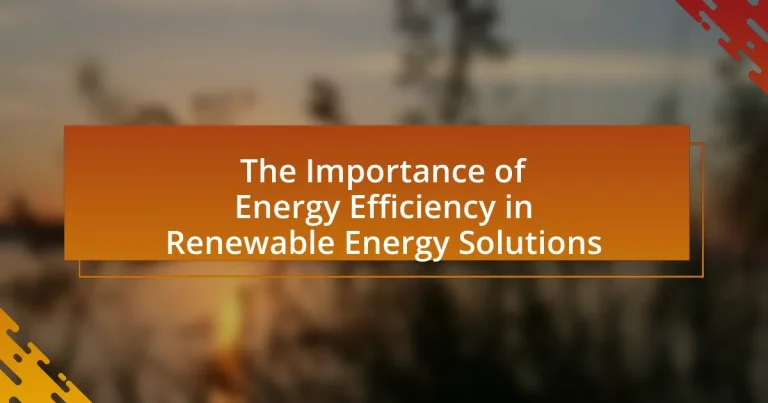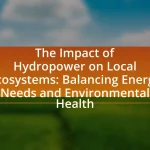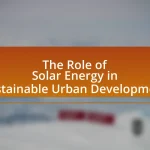Energy efficiency is a critical component of renewable energy solutions, as it enhances the output from renewable sources while reducing waste. This article explores the significance of energy efficiency in maximizing the effectiveness of solar, wind, and hydroelectric power, highlighting its role in lowering global energy demand and greenhouse gas emissions. Key principles, technologies, and practices that improve energy efficiency are discussed, along with the economic benefits and barriers to implementation. Additionally, the article examines how policy changes and individual actions can further promote energy-efficient practices within the renewable energy sector.
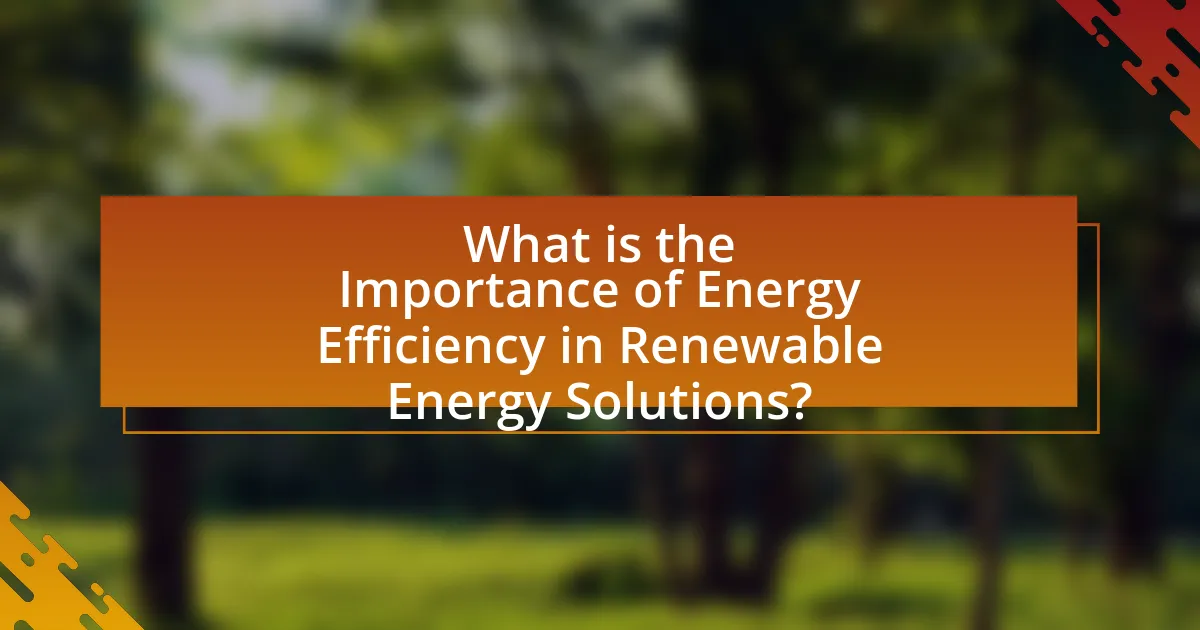
What is the Importance of Energy Efficiency in Renewable Energy Solutions?
Energy efficiency is crucial in renewable energy solutions as it maximizes the output from renewable sources while minimizing waste. By improving energy efficiency, systems can deliver more energy with less input, which is essential for optimizing the use of resources like solar, wind, and hydroelectric power. For instance, according to the International Energy Agency, enhancing energy efficiency can reduce global energy demand by up to 30% by 2040, thereby significantly lowering greenhouse gas emissions and reliance on fossil fuels. This synergy between energy efficiency and renewable energy not only promotes sustainability but also leads to cost savings and energy security.
Why is energy efficiency crucial in the context of renewable energy?
Energy efficiency is crucial in the context of renewable energy because it maximizes the output and effectiveness of renewable resources. By improving energy efficiency, less energy is required to perform the same tasks, which reduces the overall demand for energy generation. For instance, according to the International Energy Agency, energy efficiency measures can lead to a reduction in energy consumption by up to 30% in various sectors, thereby allowing renewable energy sources to meet a larger share of energy needs without necessitating additional generation capacity. This synergy between energy efficiency and renewable energy not only lowers greenhouse gas emissions but also enhances energy security and reduces costs for consumers.
How does energy efficiency impact the overall effectiveness of renewable energy systems?
Energy efficiency significantly enhances the overall effectiveness of renewable energy systems by maximizing the output from energy sources while minimizing waste. When renewable energy systems, such as solar panels or wind turbines, operate with high energy efficiency, they convert a greater percentage of the available energy into usable power, thereby increasing their overall productivity. For instance, according to the U.S. Department of Energy, improving energy efficiency in buildings can reduce energy consumption by 30% to 50%, which directly correlates with the reduced demand for energy generation from renewable sources. This synergy not only optimizes resource use but also lowers greenhouse gas emissions, making renewable energy systems more sustainable and effective in addressing climate change.
What role does energy efficiency play in reducing carbon footprints?
Energy efficiency plays a crucial role in reducing carbon footprints by minimizing energy consumption and thereby lowering greenhouse gas emissions. When energy is used more efficiently, less fuel is required to produce the same amount of energy, which directly decreases the carbon dioxide emissions associated with energy production. For instance, according to the International Energy Agency, improving energy efficiency could reduce global energy-related CO2 emissions by up to 40% by 2040. This significant reduction highlights the effectiveness of energy-efficient technologies and practices in combating climate change and promoting sustainable energy solutions.
What are the key principles of energy efficiency in renewable energy?
The key principles of energy efficiency in renewable energy include maximizing energy output, minimizing energy losses, and optimizing resource use. Maximizing energy output involves utilizing technologies that enhance the conversion of renewable resources, such as solar panels with higher efficiency ratings, which can convert more sunlight into electricity. Minimizing energy losses focuses on improving the infrastructure and systems that transport and store energy, such as using advanced grid technologies that reduce transmission losses. Optimizing resource use entails implementing strategies that ensure renewable resources are harnessed effectively, such as employing energy storage solutions to balance supply and demand. These principles are supported by studies indicating that improving energy efficiency can significantly reduce overall energy consumption and greenhouse gas emissions, thereby enhancing the sustainability of renewable energy systems.
How do energy conservation and energy efficiency differ?
Energy conservation and energy efficiency differ in their approaches to reducing energy consumption. Energy conservation involves reducing or eliminating energy use altogether, such as turning off lights when not in use or using public transportation instead of driving. In contrast, energy efficiency refers to using technology or practices that require less energy to perform the same task, such as using LED bulbs instead of incandescent ones or energy-efficient appliances. According to the U.S. Department of Energy, improving energy efficiency can lead to significant reductions in energy consumption without sacrificing comfort or productivity, highlighting the distinct yet complementary roles of both concepts in promoting sustainable energy practices.
What technologies enhance energy efficiency in renewable energy solutions?
Technologies that enhance energy efficiency in renewable energy solutions include advanced energy storage systems, smart grid technology, and high-efficiency solar panels. Advanced energy storage systems, such as lithium-ion batteries, allow for better management of energy supply and demand, enabling the storage of excess energy generated during peak production times for later use. Smart grid technology optimizes energy distribution and consumption through real-time data analysis, improving overall system efficiency. High-efficiency solar panels, which utilize technologies like monocrystalline silicon, can convert more sunlight into electricity, thereby maximizing energy output. These technologies collectively contribute to reducing energy waste and improving the overall effectiveness of renewable energy systems.
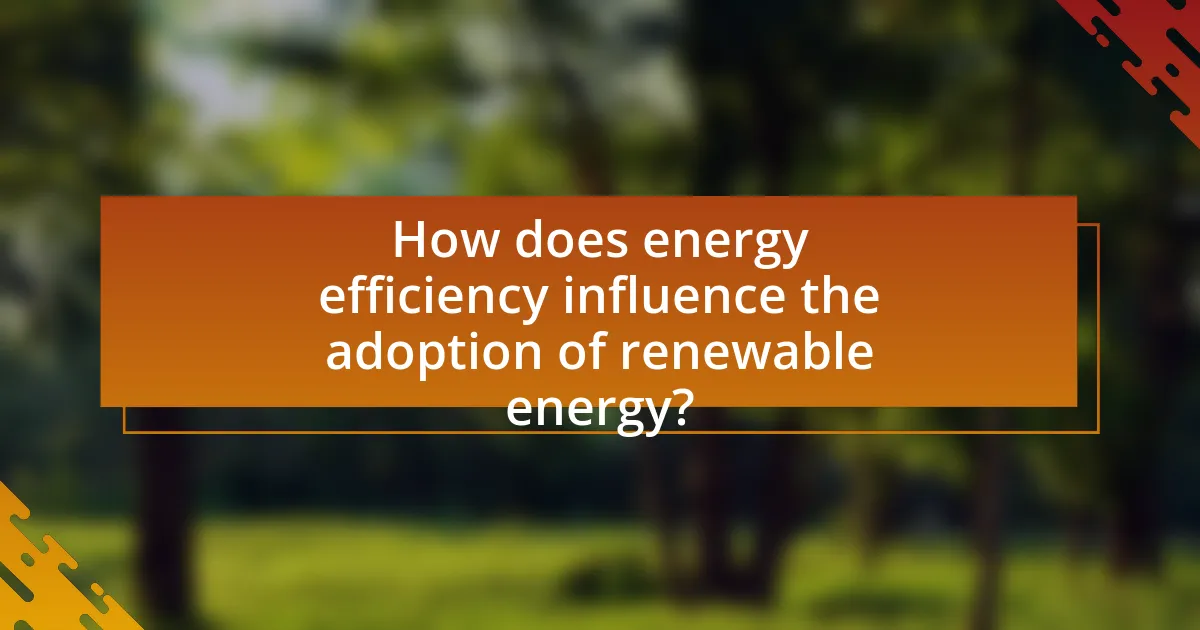
How does energy efficiency influence the adoption of renewable energy?
Energy efficiency significantly influences the adoption of renewable energy by reducing overall energy demand, which makes renewable sources more viable and attractive. When energy efficiency measures are implemented, they lower the total energy consumption, allowing renewable energy systems to meet a larger portion of energy needs without requiring extensive infrastructure investments. For instance, according to the International Energy Agency, improving energy efficiency can reduce global energy demand by up to 30% by 2040, thereby facilitating a smoother transition to renewable energy sources like solar and wind. This reduction in demand not only enhances the feasibility of integrating renewables into the energy mix but also lowers costs associated with energy production and consumption, making renewable options more competitive in the market.
What barriers exist to implementing energy-efficient practices in renewable energy?
Barriers to implementing energy-efficient practices in renewable energy include high initial costs, lack of technical expertise, regulatory challenges, and insufficient infrastructure. High initial costs deter investment, as many energy-efficient technologies require significant upfront capital, which can be a barrier for both businesses and consumers. The lack of technical expertise limits the ability to design and implement these practices effectively, as skilled professionals are essential for optimizing energy efficiency in renewable systems. Regulatory challenges arise from inconsistent policies and incentives across different regions, making it difficult for stakeholders to navigate the landscape. Additionally, insufficient infrastructure, such as outdated grid systems, hampers the integration of energy-efficient technologies into existing renewable energy frameworks. These barriers collectively hinder the widespread adoption of energy-efficient practices in the renewable energy sector.
How can policy changes promote energy efficiency in renewable energy sectors?
Policy changes can promote energy efficiency in renewable energy sectors by implementing regulations and incentives that encourage the adoption of advanced technologies and practices. For instance, governments can establish energy efficiency standards that require renewable energy systems to meet specific performance metrics, thereby driving innovation and reducing waste. Additionally, financial incentives such as tax credits or grants for energy-efficient technologies can motivate businesses and consumers to invest in more efficient renewable energy solutions. Evidence from the International Energy Agency indicates that countries with robust energy efficiency policies have seen significant reductions in energy consumption and greenhouse gas emissions, demonstrating the effectiveness of such policy changes in enhancing energy efficiency within renewable energy sectors.
What incentives encourage businesses to adopt energy-efficient renewable solutions?
Financial incentives such as tax credits, grants, and rebates encourage businesses to adopt energy-efficient renewable solutions. These incentives reduce the upfront costs associated with implementing renewable technologies, making them more financially viable. For example, the Federal Investment Tax Credit allows businesses to deduct a significant percentage of the cost of solar energy systems from their federal taxes, which has been shown to increase solar adoption rates significantly. Additionally, state-level programs often provide rebates for energy-efficient upgrades, further lowering the financial barrier for businesses. According to the U.S. Department of Energy, these financial incentives have led to a marked increase in the deployment of renewable energy technologies across various sectors.
How does energy efficiency affect the economics of renewable energy?
Energy efficiency significantly enhances the economics of renewable energy by reducing overall energy demand and lowering operational costs. When energy systems are more efficient, they require less energy input to achieve the same output, which can lead to decreased investment in renewable energy infrastructure. For instance, according to the International Energy Agency, improving energy efficiency can reduce global energy demand by up to 40% by 2040, thereby decreasing the need for extensive renewable energy installations. This reduction in demand not only lowers costs for consumers but also makes renewable energy sources more competitive against fossil fuels, as the overall market dynamics shift towards lower consumption and increased sustainability.
What are the cost savings associated with energy-efficient renewable energy solutions?
Energy-efficient renewable energy solutions can lead to significant cost savings by reducing energy bills and minimizing maintenance expenses. For instance, solar panels can lower electricity costs by up to 70% over their lifespan, which typically exceeds 25 years. Additionally, energy-efficient technologies, such as LED lighting and high-efficiency appliances, can reduce energy consumption by 20-50%, further decreasing utility expenses. According to the U.S. Department of Energy, implementing energy efficiency measures can save consumers approximately $500 billion annually by 2030. These savings are compounded by the decreasing costs of renewable technologies, which have dropped by over 80% for solar and 50% for wind energy since 2010, making them more accessible and cost-effective.
How does energy efficiency contribute to the return on investment in renewable energy projects?
Energy efficiency significantly enhances the return on investment in renewable energy projects by reducing operational costs and maximizing energy output. When renewable energy systems, such as solar panels or wind turbines, are designed with energy efficiency in mind, they can produce more usable energy while consuming less, leading to lower energy bills and quicker payback periods. For instance, a study by the International Renewable Energy Agency (IRENA) found that improving energy efficiency in conjunction with renewable energy deployment can lead to cost savings of up to 30% in energy expenditures. This synergy not only accelerates the financial viability of renewable projects but also attracts more investment by demonstrating a clear path to profitability.
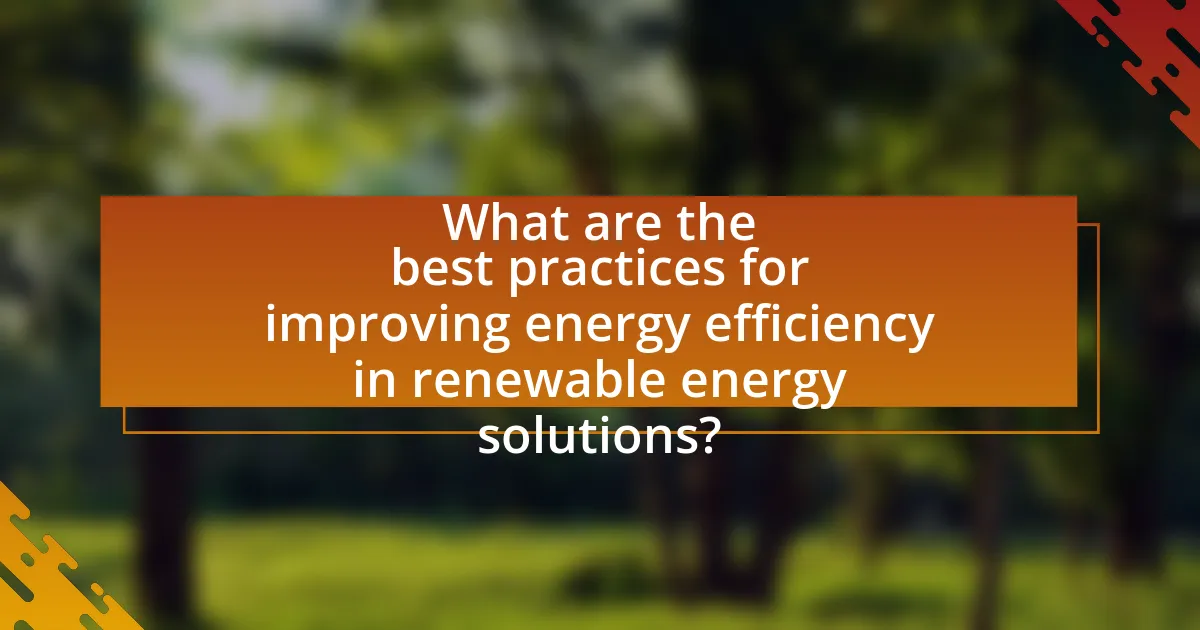
What are the best practices for improving energy efficiency in renewable energy solutions?
The best practices for improving energy efficiency in renewable energy solutions include optimizing system design, implementing advanced technologies, and enhancing energy management strategies. Optimizing system design involves selecting appropriate renewable technologies, such as solar panels or wind turbines, that maximize energy output based on site-specific conditions. Advanced technologies, like smart grids and energy storage systems, improve efficiency by balancing supply and demand, reducing waste, and enabling better integration of renewable sources. Additionally, enhancing energy management strategies through real-time monitoring and data analytics allows for continuous performance improvement and informed decision-making. These practices are supported by studies indicating that optimized systems can increase energy output by up to 30%, while smart technologies can reduce energy losses significantly.
What strategies can organizations implement to enhance energy efficiency?
Organizations can enhance energy efficiency by implementing strategies such as conducting energy audits, investing in energy-efficient technologies, and promoting employee awareness and training. Energy audits identify areas of energy waste and opportunities for improvement, allowing organizations to prioritize actions that yield the highest savings. Investing in energy-efficient technologies, such as LED lighting and high-efficiency HVAC systems, can significantly reduce energy consumption; for instance, the U.S. Department of Energy reports that LED lighting uses at least 75% less energy than traditional incandescent bulbs. Additionally, promoting employee awareness through training programs can foster a culture of energy conservation, leading to behavioral changes that further enhance efficiency.
How can energy audits help identify areas for improvement in energy efficiency?
Energy audits help identify areas for improvement in energy efficiency by systematically evaluating energy consumption patterns and pinpointing inefficiencies within a facility. Through detailed assessments, energy audits reveal specific areas where energy is wasted, such as outdated equipment, poor insulation, or inefficient lighting systems. For instance, a study by the U.S. Department of Energy found that implementing recommendations from energy audits can lead to energy savings of 10% to 30% in commercial buildings. This quantifiable data underscores the effectiveness of energy audits in enhancing energy efficiency and reducing operational costs.
What role does employee training play in promoting energy-efficient practices?
Employee training plays a crucial role in promoting energy-efficient practices by equipping staff with the knowledge and skills necessary to implement and sustain these practices effectively. Training programs focused on energy efficiency educate employees about best practices, technologies, and behaviors that reduce energy consumption, leading to significant cost savings and environmental benefits. For instance, a study by the U.S. Department of Energy found that organizations that invest in energy efficiency training can achieve energy savings of 10-30% through improved employee engagement and awareness. This demonstrates that well-structured training initiatives not only enhance employee performance but also contribute to the overall energy efficiency goals of an organization.
What future trends are shaping energy efficiency in renewable energy solutions?
Future trends shaping energy efficiency in renewable energy solutions include advancements in energy storage technologies, integration of artificial intelligence for optimization, and the development of smart grids. Energy storage technologies, such as lithium-ion batteries and emerging solid-state batteries, enhance the ability to store renewable energy, thereby improving efficiency and reliability. The integration of artificial intelligence allows for real-time data analysis and predictive maintenance, optimizing energy consumption and reducing waste. Smart grids facilitate better energy distribution and management, enabling a more efficient use of renewable resources. These trends are supported by the increasing investments in clean energy technologies, projected to reach $1 trillion annually by 2030, according to the International Energy Agency.
How is technology evolving to improve energy efficiency in renewable energy?
Technology is evolving to improve energy efficiency in renewable energy through advancements in smart grid systems, energy storage solutions, and enhanced materials for energy generation. Smart grid technology enables real-time monitoring and management of energy distribution, optimizing the use of renewable sources and reducing waste. Energy storage innovations, such as lithium-ion batteries and flow batteries, allow for better integration of intermittent renewable sources like solar and wind, ensuring a steady energy supply and minimizing losses. Additionally, the development of high-efficiency photovoltaic cells and wind turbine designs has significantly increased the energy conversion rates, with some solar panels achieving efficiencies over 22% and modern wind turbines generating more power at lower wind speeds. These technological advancements collectively enhance the overall energy efficiency of renewable energy systems, making them more viable and sustainable.
What emerging policies are likely to influence energy efficiency in the renewable sector?
Emerging policies likely to influence energy efficiency in the renewable sector include stricter energy performance standards, financial incentives for energy-efficient technologies, and regulations promoting renewable energy integration. Stricter energy performance standards, such as those proposed in the European Union’s Green Deal, aim to reduce energy consumption in buildings and industries, thereby enhancing overall energy efficiency. Financial incentives, like tax credits and grants for renewable energy projects, encourage the adoption of energy-efficient technologies, as seen in the U.S. Inflation Reduction Act, which allocates significant funding for clean energy initiatives. Additionally, regulations that promote the integration of renewable energy sources into existing energy grids, such as California’s Renewable Portfolio Standard, drive improvements in energy efficiency by optimizing resource use and reducing waste. These policies collectively aim to create a more sustainable and efficient renewable energy landscape.
What practical steps can individuals take to support energy efficiency in renewable energy?
Individuals can support energy efficiency in renewable energy by adopting energy-saving practices and technologies in their daily lives. This includes using energy-efficient appliances, which can reduce energy consumption by 10-50% compared to standard models, thereby decreasing overall energy demand. Additionally, individuals can install smart thermostats that optimize heating and cooling, leading to energy savings of up to 15%.
Furthermore, participating in local renewable energy programs, such as community solar initiatives, allows individuals to contribute to the generation of clean energy while promoting energy efficiency. According to the U.S. Department of Energy, energy efficiency measures can reduce energy use in homes by 20-30%, significantly lowering greenhouse gas emissions.
Lastly, individuals can educate themselves and others about energy conservation techniques, such as proper insulation and energy-efficient lighting, which can further enhance energy efficiency in renewable energy systems.
